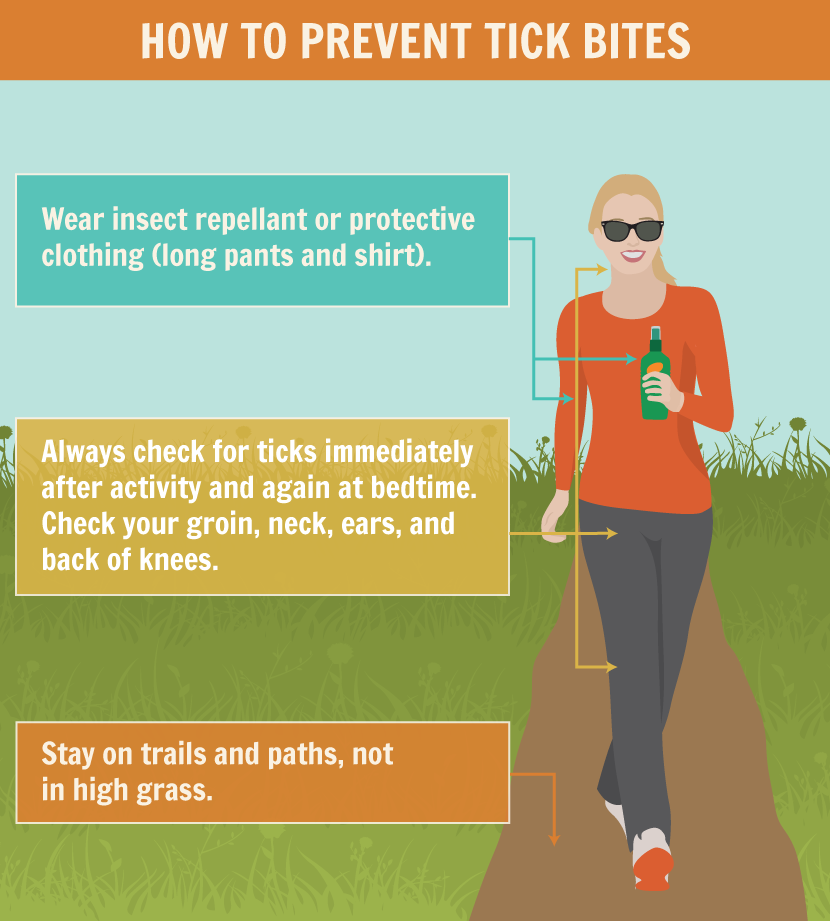Ticks are nature’s dirty needles so to avoid getting sick, avoid tick bites.
Avoid walking in long grass and thick low lying bush with overhanging shrubs and small trees, especially after a rainy or humid day.
Ticks wait on the leaves of shrubs and small trees with legs extended, questing for hosts. They can detect heat emission and carbon dioxide from their host and latch on to them. They prefer warm, moist environments on the body (eg behind the ears, armpit or head). Ticks secrete an anaesthetic in their saliva so you will not feel their bite or their attachment. If you do get bitten by a tick, see out tick removal page.

Important tips for preventing tick bites:

Wear a wide brimmed hat and long-sleeved shirt.
Protect your head and neck with light-coloured clothing so you can see small ticks, especially nymphs, tuck your shirt inside your pants.

Tuck your pants into your socks.
This will stop tick attaching themselves to your legs.

Use insect repellant.
Spray on a recommended skin repellant (see below). Use insecticide containing permethrin on boots and clothing. The effects will last several days.

Always walk on clear tracks.
This will decrease the chance of brushing past a tick bearing plant.

Check your body, children and pets for ticks.
Tick checks are vital after hiking or walking. Conduct a thorough search especially behind the ears, in the hair and on the back of the head.

Have a tick clear garden.
Cut grass and trim the shrubs and small trees (to allow sunlight to saturate the lawn) around your house.

Regularly remove plant debris.
Remove garden rubbish and undergrowth to remove moist vegetation where ticks thrive. Store firewood in a sunny dry place away from vegetation to discourage ticks from living there.

Grow insect repelling plants.
Ticks a repelled by plants such as chrysanthemums, citronella, lavender, sage or garlic.

Discourage wildlife around your house.
Bandicoots, wallabies, possums, lizards and other small animals carry ticks and deposit them in and around your house.

Brush skin and clothing before entering the house or vehicle.
All clothing should be changed. Put in a plastic bag and then into a dryer on high heat for 30 minutes to kill ticks.
Insect Repellent Sprays
Insect repellents containing natural ingredients may not provide complete protection e.g tea tree oil, rosemary and eucalyptus oil (contraindicated in infants less than 3 years old). However, multiple repetitive tick encounters can be reduced with natural oils, especially if allergic to pesticides. Repellent sprays that are not permethrin or picaridin based may not provide complete protection also. One exception is BioUD a product from tomato plants that has been shown to be as effective or more effective than DEET (depending on tick species) and more effective than permethrin at repelling ticks (Bissinger et al., 2009).
Recommended:
- 20% DEET (not on children) (Rid®, Tropical strength Aerogard® 17%, Bushman’s® 40%)
- 16% picaridin (Off Tropical Strength®)
- BioUD – a new product thought to be less toxic than DEET.
- Mighty Tick Off, an electronic tick-repelling device, is currently being trialled.
Lotions and gels last longer than sprays.
Clothes – Insecticide Application
Pyrethroids or picardin sprays can be applied directly to clothes and shoes. Deet can also be used but may deteriorate plastics and other surfaces.
Ether containing aerosol sprays – Aerostart and Wart-Off Freeze (see the Australasian Society of Clinical Immunology and Allergy)
Ether containing aerosol sprays kill the tick by rapid freezing. It appears that further injection of allergen containing saliva is minimized but human studies need to be conducted to clarify.
